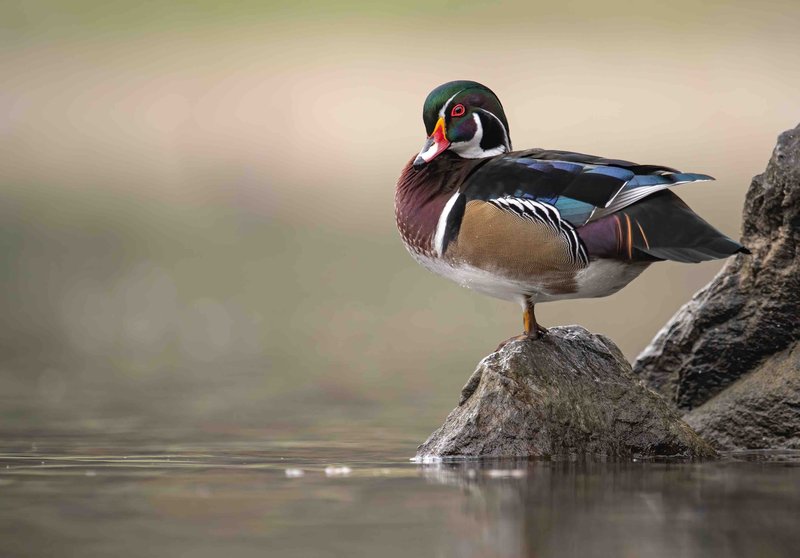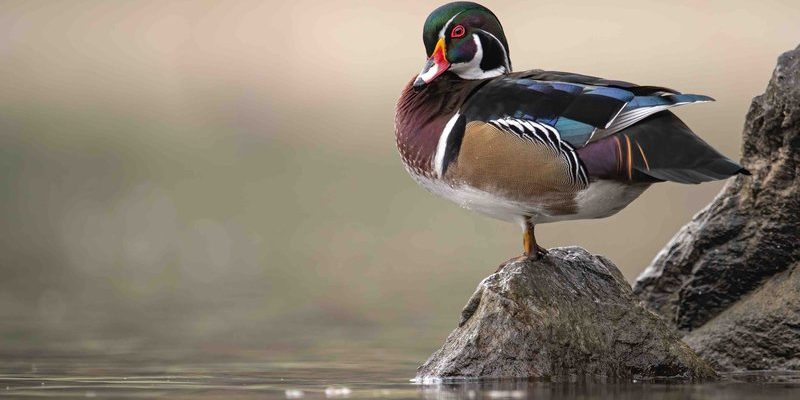
So, why should you care about the wood duck? Well, they’re not just beautiful; they also play an essential role in their ecosystems. You might be surprised at how much these elegant birds can teach us about nature, survival, and adaptability. Grab your favorite beverage, and let’s dive into the ten most interesting facts about the wood duck!
1. Stunning Appearance
The wood duck is often regarded as one of the most colorful ducks in North America. With its iridescent plumage, it sports a combination of striking greens, blues, and purples, along with a unique white throat patch. Honestly, it’s hard not to do a double-take when you see one! The males are particularly vibrant, with their bold colors and eye-catching patterns, while females are more subdued but still elegant with their soft browns and white eye rings.
These gorgeous colors serve a purpose, too! The vibrant plumage of wood ducks helps them attract mates during the breeding season. In the world of birds, appearance is a crucial factor in finding a partner. Just like humans might dress up for a date, wood ducks flaunt their feathers in a colorful display. You might be wondering how they maintain such beauty. The answer lies in a special oil they produce, which helps keep their feathers waterproof and vibrant.
2. Incredible Adaptability
One of the wood duck’s most remarkable traits is its adaptability. Unlike many other duck species that prefer open water, wood ducks thrive in wooded swamps, marshes, and ponds. They often nest in tree cavities, showing a unique preference for higher ground. This behavior allows them to avoid predators and provides a safe haven for their young.
Moreover, wood ducks are also excellent at flying through densely wooded areas. While some ducks might require open spaces to take off and land, wood ducks can navigate through trees with ease. Imagine trying to walk through a crowded café and finding your way without bumping into anyone; that’s how skilled these birds are! This adaptability has allowed wood ducks to thrive even in areas that have experienced habitat loss.
3. Unique Nesting Habits
Wood ducks have a fascinating nesting ritual that sets them apart from other waterfowl. They typically nest in tree cavities, often reaching heights of up to 50 feet. Instead of building a traditional nest on the ground, they climb trees and find a cozy spot in a hollow. This not only protects their eggs from predators but also gives the ducklings a safe exit strategy when they’re ready to explore their surroundings.
When it’s time for the female to lay eggs, she can lay anywhere from 6 to 15 eggs in a clutch. After about 30 days of incubation, the ducklings hatch and are ready to jump! You might be surprised to learn that they can leap from their high nests and land safely on the ground. They’re like tiny little parachutes! This adaptability in nesting sites and hatching methods is a testament to their survival instincts.
4. A Diet for All Seasons
The wood duck’s diet is as diverse as its habitat. These birds are omnivorous, which means they eat a wide range of foods. In the warmer months, they enjoy a diet rich in insects, aquatic plants, and seeds. However, come autumn and winter, their diet shifts to include more nuts and grains, which can be found in abundance during these seasons.
Think of it like preparing for a cozy winter meal. Just as we might stock up on hearty foods when it gets cold, wood ducks are smart enough to adapt their diet to make sure they have enough to eat throughout the year. This diet flexibility is crucial for their survival, especially when food sources can be scarce during harsh weather conditions.
5. Social Creatures
Wood ducks are social birds and often form small groups. You might see them floating gracefully in a pond, chatting with one another. They have a range of vocalizations, from soft whistles to louder quacks, which they use to communicate with each other. This social aspect is especially evident during the breeding season when you’ll see males displaying their impressive plumage to attract females.
Interestingly, they also engage in a behavior known as “social monogamy.” This means that while they may mate with a primary partner for a breeding season, they don’t necessarily stick to that partner for life. It’s like being in a series of short-term relationships—keeping things fresh while ensuring their genes get passed on.
6. Conservation Status and Efforts
Despite their adaptability, wood ducks faced significant threats in the past. Overhunting and habitat loss in the 19th and early 20th centuries led to their decline. However, thanks to conservation efforts, their population has rebounded in recent years. Organizations like the North American Wood Duck Society have played a crucial role in promoting wood duck protection and awareness.
You might be curious about what these efforts involve. Conservationists work on habitat restoration, creating artificial nesting boxes, and implementing sustainable hunting practices. These initiatives are essential for maintaining healthy populations of wood ducks and ensuring they continue to thrive. Just like planting a garden, nurturing these birds takes time and dedication, but the rewards are worth it!
7. Migration Patterns
Wood ducks are considered partial migrators. While some populations migrate to warmer areas for the winter, others remain in their breeding grounds year-round. Their migration isn’t as extensive as some other bird species, but those that do migrate typically move south to find better feeding grounds.
If you’re lucky enough to observe them during migration, you might notice groups flying in a V-formation. This helps them conserve energy and provides safety in numbers. It’s fascinating to realize that even in the bird world, teamwork can make a difference!
8. Lifespan and Maturity
The average lifespan of a wood duck is about 3 to 4 years in the wild, but some have been known to live up to 15 years under ideal conditions. They typically reach sexual maturity at about 1 year of age. Once they do mature, they can begin to breed and contribute to future generations.
Just like humans, these ducks face various challenges in their lives, from predators to environmental factors. It’s a reminder that survival is a journey, not just a destination. As they face these challenges, their resilience is what keeps their species thriving.
9. Importance in Ecosystems
Wood ducks play a vital role in their ecosystems. As they feed on aquatic plants, insects, and seeds, they contribute to the health of wetland environments. Their foraging habits help maintain plant populations and the balance of insects in their habitats. Think of them as nature’s little gardeners!
Additionally, they serve as prey for various predators, including hawks and foxes. This interdependence illustrates how every creature, no matter how small, has its place in the grand tapestry of life. The presence of wood ducks indicates a healthy ecosystem, making them important indicators of environmental health.
10. Cultural Significance
Lastly, wood ducks hold a special place in various cultures and traditions. They have been featured in art, folklore, and even hunting traditions. Many Native American groups regarded wood ducks as symbols of beauty and grace. Their striking appearance and unique behaviors have inspired countless artists, making them a beloved subject in paintings and literature.
As you explore the natural world, keep an eye out for these remarkable birds. Their beauty and resilience remind us of the wonders of nature and the importance of conservation. Just as you might cherish a favorite book or song, wood ducks have secured their spot in our hearts and culture through their enchanting presence.
In conclusion, the wood duck is more than just a pretty face. Its unique adaptations, social behaviors, and significance in ecosystems make it truly remarkable. Whether you’re an avid birdwatcher or just starting to learn about these incredible creatures, there’s so much to appreciate about the wood duck. So, the next time you’re by a pond or a wooded area, take a moment to look for these vibrant birds and enjoy the wonders of nature!

